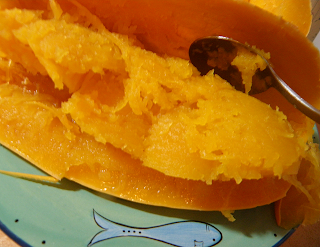 |
| From 4.5 lb. Squash |
Recipe by Robin
Many people have resolved to lose weight in 2012, and to
start losing it as soon as possible. I wouldn’t mind knocking off 5 or 10 lbs.
myself, which is not that easy for a food blogger with a sedentary day job and
a whole lot of persimmons to cook up. Nonetheless, I believe that over time
small choices can make a big difference—like choosing to eat spaghetti squash
in place of regular pasta. It’s filling and satisfying, and doesn’t have the
addictive textural quality that wheat pasta seems to for me. Plus, spaghetti
squash still available in stores from last autumn’s harvest, and is often
discounted.
We usually start with a squash that weighs around 5 lbs.
This yields about 4 hearty meals for my husband and myself, when paired with
any sort of veggies in tomato sauce and a salad. Tonight we are serving it with
Baked
Tomato Sauce that I made and froze last September, and some mini turkey meatballs
(recipe later this week).
 |
| Remove Seeds with Spoon |
Speaking of microwaving, last year I microwaved a 7 lb.
spaghetti squash. Believe it or not, there was a label with microwave
instructions stuck to the squash. In theory this is a good idea—the squash
cooks from the moisture within itself. But, I would not try it again with a
large squash (and have seen very few small spaghetti squashes). It’s hard to
tell how “done” it is getting from the outside, it requires constant monitoring
while cooking to avoid exploding, and it’s hot and steamy as heck when you
slice it open, even after allowing it to rest. Also, the taste of the seeds—raw
seeds—seemed noticeable in the “spaghetti” strands. And, IF there happens to be
a bad spot, you won’t see it, and the rotten flavor could well permeate the
good parts as well.
 |
| Use Spoon to Separate Squash from Skin |
This was the first spaghetti squash I’d ever seen with a bad
spot. There was slight greyish discoloration of the skin outside, and the flesh
was soft and spongy. The spot was easy to scoop out, then I cut around the
edges with a knife to remove about ¼ inch of the adjacent area. The remainder of the squash tastes
fine. So if you happen to find a squishy-texture area on your squash, just cut
it out and bake as usual.
Preparing Spaghetti Squash for Cooking
It’s difficult to slice a large, hard squash exactly in
half, and doesn’t matter in terms of cooking or presentation how equal the
halves are. Expertvillage has posted a great video for slicing spaghetti squash with a large, sharp knife. We use a similar method in that we begin
in the middle and cut towards the edges, but we use a large cleaver and a
rubber mallet. Tap the cleaver into the spaghetti squash from the middle to
each end, similar to the slicing motion in the video, and it will break in
half, sooner or later. Proceed slowly and carefully.
Scoop out the seeds and fine orange fibers. These fibers are
not the “spaghetti,” which is the yellow flesh that will separate into strands when cooked.
Cooking Spaghetti Squash
Preheat oven to 350 degrees F.
Place halves upside-down in a baking dish and fill with
about ¾” of water. Put baking pan
into preheated oven and bake for 45 minutes to 1 hour. When done, the surface
will hold a slight dent when pressed with a spoon back.
Using potholders or tongs, remove squash from water and
invert on plate to cool.
When cool enough to handle, either scoop out by pulling a
fork lengthwise “against the grain,” or run a spoon just inside the skin to pop
the flesh out, then separate the strands with a fork.
Eating the “Spaghetti”

No comments:
Post a Comment